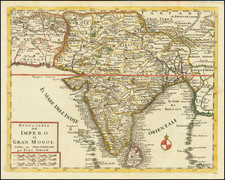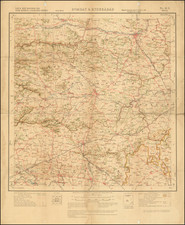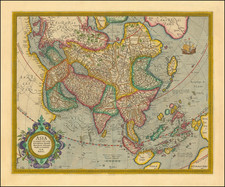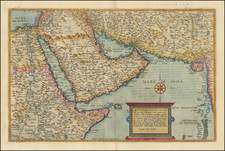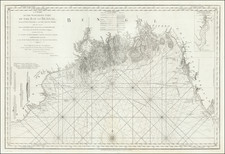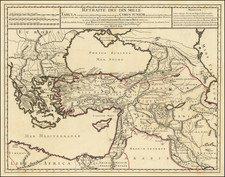Rare Second State of the Most Important 16th Century Map of the Middle East, etc.
Fine example of Giacomo Gastaldi's rare 2-sheet wall map of the Middle East, covering Egypt, the Holy Land, the Horn of Africa, the Arabian Peninsula, and extending east across the Arabian Sea to the west coast of India.
Gastaldi's 2-sheet map of the region is generally considered to be the single most influential map of the region published in the 16th century. The map would later be directly copied by Abraham Ortelius, Cornelis De Jode and Gerard Mercator in their respective atlases and other maps.
In describing the map, Taleghani, et al noted:
"In this large-scale map there appeared for the first time much material which was to recur in all western maps for the next century and a half, (Tibbetts, 1978:20). Gastaldi's representation of the Gulf broke with the Ptolemaic model: no longer a rectangle, it acquires its form of a segment and begins to take on its true contours. Ortelius, Mercator and other Dutch geographers then based their depictions of the Gulf on Gastaldi.
Suarez describes at length the sources and innovations used by Gastaldi for all of his Asian continental maps, but foremost the three-sectional maps "had a major influence on the work of Ortelius and de Jode... In their representation of the coastlines his maps are superior to all previous known maps of Asia, either drawn by hand or printed" (Schilder in The Map Collector no. 17, p. 7).
Nordenskiöld notes:
Finally, it must be remembered that Gastaldi, under the guidance of Ramusio, is supposed to have aided in repairing or repainting the famous wall-maps in Sala dello scudo in Venice . . . If such was the case, it may be considered probable that the monumental maps of Africa and Asia by Gastaldi have had some connection to [Gastaldi's map of Asia], that these copper-plate engravings are a reproduction of the originals of the wall maps in that form which was given them in the middle of the sixteenth century.
State
The present example is a rare variant edition, bearing the imprint of "Petri de Nobilibus Formis." Pietro de Nobilis was a successor of Lafreri in Rome after 1580. Also, above the scale of miles is a further imprint reading: "In Roma appresso Paulo de Graciam."
Rarity
The second state is extremely rare. Tooley located only a single example in the Beans collection (now sold). Stefano Bifolco, in his recent census for his upcoming book on Italian Printed Maps from the 16th Century locates only 2 examples, Malta National Library and Jerusalem National Library (ex-Laor).
Giacomo Gastaldi (1500-1566) is considered the foremost Italian cartographer of the sixteenth century, alongside Paolo Forlani. His skills of compilation are comparable to those of Mercator and Ortelius, yet much less is known of his life than of his two contemporaries. Gastaldi was born in Villafranca, Piedmont, but had established himself in Venice by 1539. He originally worked as an engineer, but turned to mapmaking from the 1540s onward.
It was in Venice where he made his reputation as an engraver, geographer, and cosmographer; for example, he was asked to fresco maps of Asia and Africa in the Palace of the Doge, or the Council of Ten, Venice’s governmental body. He also frequently consulted on projects for the Savi sopra la Laguna, drawing maps for this body which oversaw the regulation of fresh and salt water around Venice.
His contemporaries also recognized his skill, as he was named cosmographer to the Republic of Venice, was a member of the Accademia Veneziana, and was a major source for other geographers and mapmakers including Camocio, Bertelli, Cock, Luchini, and Ortelius. He even had his own distinct style of copper engraving that made him a pioneer in his day and makes his works iconic today.
Gastaldi enjoyed an especially productive relationship with Giovanni Battista Ramusio, Secretary of the Venetian Senate, who used Gastaldi's maps for his famous travel account collection, Navigationi et Viaggi. Gastaldi also tutored Ramusio's son in cosmography.









